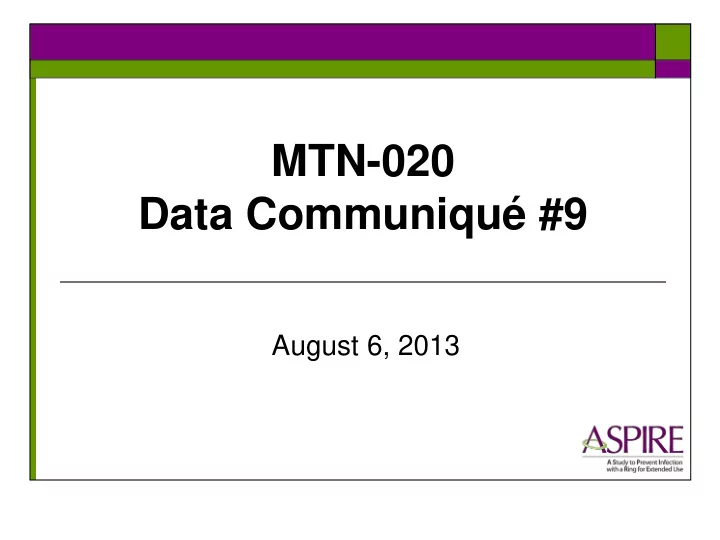

MTN-020 Data Communiqué #9 August 6, 2013
Updated Ring Adherence (RA-1) CRF Version 1.0 – 30Jul13 Form instructions: Item 4 text “in the past month” added to clarify that the longest number of days in a row the vaginal ring has been out applies to the past month only (maximum 31 days). The previous Item 5 response boxes have been replaced with Reason Code boxes.
Updated Ring Adherence (RA-1) CRF Version 1.0 – 30Jul13 Form instructions: General information/Instructions, Items 1 & 2 updated to clarify intent of questions Reason Codes added to Item 5 instructions with bolded lead-in text for easy identification Reasons for ring removals grouped into new categories Reason codes 10 & 14 text amended per Data Communique #8 Additional reasons added based on data review of site responses to date
Updated Ring Adherence (RA-1) CRF Version 1.0 – 30Jul13 Atlas Visit Packets have been updated to include new RA-1 CRF A separate document, “MTN020 Ring Adherence CRF: Item 5 Reason Code List” is available under ‘Other documents’ on Atlas as a reference to aid staff in completing item 5. Sites can begin transitioning to this new form immediately The previous RA-1 CRF may continue to be used until August 12, 2013 . Starting on this date, all sites are expected to use the new version exclusively.
Ring Worries (RW-1), Item 3 If a participant permanently discontinues from study product prior to her scheduled PUEV, complete all items on the RW-1 CRF, including Item 3, at the permanent discontinuation visit instead of the PUEV.
AE-1/GAE-1 Log CRFs – Item 4 Rationale If a previously completed GAE-1/AE-1 Log CRF page is updated with new information (for ex. a change to product relatedness or a medication taken for the AE), review other items on the page for consistency and update as needed. If AE relationship to the vaginal ring changes due to test results confirming a diagnosis, update both Item 1 and Item 4. Example 1: To resolve CQC, AE Text (Item 1) should be updated to specify the STI to be consistent with the rationale in Item 4.
AE-1/GAE-1 Log CRFs – Item 4 Rationale If a previously completed GAE-1/AE-1 Log CRF page is updated with new information (for ex. A change to product relatedness or a medication taken for the AE), review other items on the page for consistency and update as needed. If AE relationship to the vaginal ring changes due to test results confirming a diagnosis, update both Item 1 and Item 4. Example 2: To resolve CQC, AE Text (Item 1) should be updated to report ‘vaginal infection’ or ‘vulvovaginitis’ unless more specific dx is known to be consistent with the rationale in Item 4.
AE-1/GAE-1 Log CRFs – Item 4 Rationale If a previously completed GAE-1/AE-1 Log CRF page is updated with new information (for ex. A change to product relatedness or a medication taken for the AE), review other items on the page for consistency and update as needed. If AE relationship to the vaginal ring changes due to test results confirming a diagnosis, update both Item 1 and Item 4. Example 3: To resolve CQC, AE Text (Item 1) should be updated to report ‘‘vulval infection’ or ‘vulvovaginitis’ unless a more specific dx is known to be consistent with the rationale in Item 4.
Concomitant Medications – Coding Query Examples If a trade name is not available/ or not reportable per national guidelines, record the generic name of the medication. A combination medication with a known generic name, can be recorded as one entry on the CM-1. For example: If a combination medication does have a known generic name, each active ingredient must be reported as a separate entry in order to be accurately coded at SCHARP.
Concomitant Medications – Coding Query Examples Example 1: This item should be recorded as 2 separate entries on CM-1: 1. Chloramphenicol 2. Dexamethason
Concomitant Medications – Coding Query Examples Example 2: This item should be recorded as 4 separate entries on CM-1: 1. Camphorated tincture of opium 2. Tolu 3. Squill 4. Liquorice liquid extract
Concomitant Medications – Coding Query Examples Example 3: This item should be recorded as 3 separate entries on CM-1: 1. Vitamin A 2. Thiamin 3. Riboflavin
Concomitant Medications – Coding Query Examples Minor spelling differences can affect the coding of medications. Please ensure the correct and consistent spelling of medications throughout the study. Ex. 1: Aluminium Hydroxide vs. Ex. 2: Hydroxyzine vs. Hydroxizine Aluminum Hydroxide Ex. 3: Azithromycin Mylan vs. Azithromycine Mylan
Ring Collection/Insertion (RCI-1) CRF – item 4a Item 4a: - If a new ring is not dispensed, mark ‘participant declined the study ring’ if the participant herself declined the study ring OR if the participant declined study ring due to family or partners’ wishes. - Provide details on the adjacent specify line.
Product Hold/Discontinuation (PH-1) CRF – item 4 Item 4: “no - early termination” response Mark “no-early termination” for Item 4 if a participant terminates early while the product hold is still in place and enter the date of the early termination visit.
Questions? Please contact Jen Berthiaume and Karen Patterson with any questions you have about this slide presentation or the Data Communiqué. Email us at: jberthia@scharp.org karenp@scharp.org
Recommend
More recommend